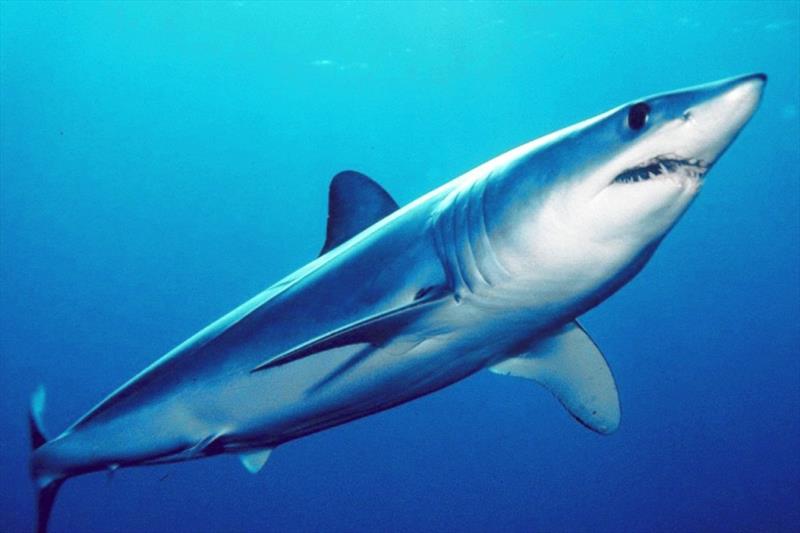
12 shark facts that may surprise you
by NOAA Fisheries 28 Jul 2018 05:55 UTC

Shortfin mako shark © NOAA Fisheries
1. Sharks do not have bones
Sharks use their gills to filter oxygen from the water. They are a special type of fish known "elasmobranch", which translates into fish made of catilaginous tissues—the clear gristly stuff that your ears and nose tip are made of. This category also includes rays, sawfish, and skates. Their cartilaginous skeletons are much lighter than true bone and their large livers are full of low-density oils, both helping them to be buoyant.
Even though sharks don't have bones, they still can fossilize. As most sharks age, they deposit calcium salts in their skeletal cartilage to strengthen it. The dried jaws of a shark appear and feel heavy and solid; much like bone. These same minerals allow most shark skeletal systems to fossilize quite nicely. The teeth have enamel so they show up in the fossil record too.
2. Most sharks have good eyesight
Most sharks can see well in dark lighted areas, have fantastic night vision, and can see colors. The back of sharks' eyeballs have a reflective layer of tissue called a tapetum. This helps sharks see extremely well with little light.
3. Sharks have special electroreceptor organs
Sharks have small black spots near the nose, eyes, and mouth. These spots are the ampullae of Lorenzini – special electroreceptor organs that allow the shark to sense electromagnetic fields and temperature shifts in the ocean.
4. Shark skin feels similar to sandpaper
Shark skin feels exactly like sandpaper because it is made up of tiny teeth-like structures called placoid scales, also known as dermal denticles. These scales point towards the tail and help reduce friction from surrounding water when the shark swims.
5. Sharks can go into a trance
When you flip a shark upside down they go into a trance like state called tonic immobility. This is the reason why you often see sawfish flipped over when our scientists are working on them in the water.
6. Sharks have been around a very long time
Based on fossil scales found in Australia and the United States, scientists hypothesize sharks first appeared in the ocean around 455 million years ago.
7. Scientists age sharks by counting the rings on their vertebrae
Vertebrae contain concentric pairs of opaque and translucent bands. Band pairs are counted like rings on a tree and then scientists assign an age to the shark based on the count. Thus, if the vertebrae has 10 band pairs, it is assumed to be 10 years old. Recent studies, however, have shown that this assumption is not always correct. Researchers must therefore study each species and size class to determine how often the band pairs are deposited because the deposition rate may change over time. Determining the actual rate that the bands are deposited is called "validation".
8. Blue sharks are really blue
The blue shark displays a brilliant blue color on the upper portion of its body and is normally snowy white beneath. The mako and porbeagle sharks also exhibit a blue coloration, but it is not nearly as brilliant as that of a blue shark. In life, most sharks are brown, olive, or grayish.
9. Each whale shark's spot pattern is unique as a fingerprint
Whale sharks are the biggest fish in the ocean. They can grow to 12.2 meters and weigh as much as 40 tons by some estimates! Basking sharks are the world's second largest fish, growing as long as 32 feet and weighing more than five tons.
10. Some species of sharks have a spiracle that allows them to pull water into their respiratory system while at rest. Most sharks have to keep swimming to pump water over their gills
A shark's spiracle is located just behind the eyes which supplies oxygen directly to the shark's eyes and brain. Bottom dwelling sharks, like angel sharks and nurse sharks, use this extra respiratory organ to breathe while at rest on the seafloor. It is also used for respiration when the shark's mouth is used for eating.
11. Not all sharks have the same teeth
Mako sharks have very pointed teeth, while white sharks have triangular, serrated teeth. Each leave a unique, tell-tale mark on their prey. A sandbar shark will have around 35,000 teeth over the course of its lifetime!
12. Different shark species reproduce in different ways
Sharks exhibit a great diversity in their reproductive modes. There are oviparous (egg-laying) species and viviparous (live-bearing) species. Oviparous species lay eggs that develop and hatch outside the mother's body with no parental care after the eggs are laid.